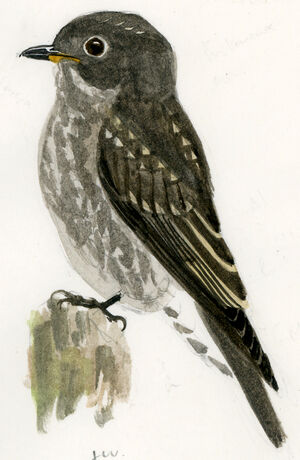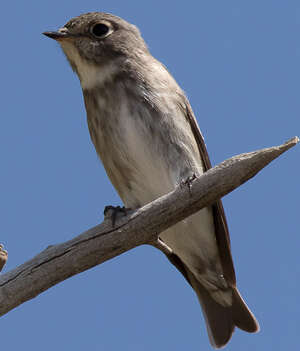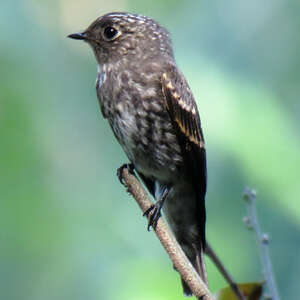Dark-sided Flycatcher
Muscicapa sibirica - Gobemouche de Sibérie
Identification
Medium-sized flycatcher, a bit smaller than our Gray Flycatcher. It is a big migrator with very long wings extending widely onto the tail, making it look shorter. Like some other flycatchers of similar behavior, this bird has plain discreet plumage, all in shades of gray and brown. Identification is therefore not easy.
First the adult is recognized by its lower parts. As suggested by its English name, Dark-sided Flycatcher, the sides of the chest are dark and separated by a longitudinal median band which is clearer. Seen from far, these dark sides appear united, but seen up close, one can distinguish dark blackish streaks on a gray background. The upper chest shows a darker pectoral band which contrasts with the clear throat. Another specific criteria is that the under-tail feathers are marked gray while they are white on its congener, the Spotted Flycatcher. Compared to the latter, the head pattern is less defined. The lores are more uniform, lightly tawny, and the sub-mustache and malar stripes less obvious. The white eye circle is more visible. Moreover, its head looks wider and the beak smaller.
The upper parts are gray-brown, their uniformity being disrupted by beige edgings to the inner remiges and the coverts.
There are four sub-species which differ only in nuances of the plumage which can be darker or lighter above and below.
The juvenile plumage is even darker, with streaks and tawny spots on the head and upper parts and edgings of the same color on the wing feathers. The underside can have a mottled or scaled aspect.
Subspecific information 4 subspecies
- Muscicapa sibirica sibirica (c and s Siberia to Korea and Japan)
- Muscicapa sibirica gulmergi (ne Afghanistan and nw Himalayas)
- Muscicapa sibirica cacabata (c Himalayas to s Tibet and ne India)
- Muscicapa sibirica rothschildi (c and s China to n Myanmar and nw Vietnam)
Foreign names
- Gobemouche de Sibérie,
- Papamoscas siberiano,
- taralhão-siberiano,
- Rußschnäpper,
- Roetvliegenvanger,
- Pigliamosche fianchiscuri,
- sibirisk flugsnappare,
- Gråflankefluesnapper,
- muchár krátkozobý,
- lejsek tmavoboký,
- Sibirisk Fluesnapper,
- siperiansieppo,
- papamosques siberià,
- muchołówka śniada,
- tumšais mušķērājs,
- Сибирская мухоловка,
- Sikatan sisi-gelap,
- サメビタキ,
- 乌鹟,
- นกจับแมลงสีคล้ำ,
- 烏鶲,
Voice song and call
The Dark-sided Flycatcher is silent outside the breeding season. Calls and songs are just as simple, at least to a human ear, as those of other Muscicapa. There are repeated chip calls alternating with trills or sharp sih. The song consists of very high-pitched notes, probably close to ultrasounds, emitted alone or in series. They can barely be heard.
Habitat
The Dark-sided Flycatcher breeds in coniferous high-altitude forests in the south of its range and in Siberian taiga in the north, often close to water.
During migration, this bird can be observed in many non-forested but wooded areas: scrub, open woodlands, parks and gardens, plantations, etc. In winter, it can be found in the wooded areas, where it prefers the canopy.
Behaviour character trait
The Dark-sided Flycatcher has behaviour quite similar to that of the Grey Flycatcher. It is perhaps a bit more firmly a forest-dweller, but like the latter, it appreciates forestry-throughs, clearings, linear water courses or routes. It must have a clear view of the hunting areas. Favourable places can see the gathering of several individuals or couples. Like other flycatchers, it sometimes descends to the ground to capture prey.
Flight
Dietfeeding habits
Reproduction nesting
The nesting season varies depending on the subspecies. It generally lasts from May to August. Therefore, it is late, due to the high-altitude or latitude habitats occupied. Little is known about the nesting. It is the female who builds the nest out of moss, lichens, grass, leaves, animal hair and feathers in a fairly sheltered spot, such as a tree hole, burl, broken branch or one covered in moss and/or lichens. The female lays 3-4 eggs there.
Geographic range
As its name implies, the nominate subspecies breeds in Eastern Siberia, from Lake Baikal to the Kamchatka Peninsula. It also breeds on Sakhalin Islands and in Japan. The other subspecies have a more southerly range, from northern Afghanistan to central and southern China.
Its wintering range is disjunct, stretching from southern China to Sumatra and Borneo through Indochina and the Malay Peninsula.
Post-breeding migration lasts from late August to November. Siberian birds return to their breeding grounds late, in late May.
Threats - protection
IUCN conservation status
concern
in the Wild
threatened
evaluated
The Dark-sided Flycatcher is not currently threatened. It is usually quite common to common. There is little information available on its specific density. It has been noted that in the Himalayas, 2 to 3 couples can nest within 50 meters of each other, which may indicate a semi-colonial character of the species.
Sources of information
- IOC World Bird List (v15.1), Gill, F and D Donsker (Eds). 2025-12-07.
- Vol. 12 - Handbook of the Birds of the World, Josep del Hoyo-Andrew Elliott-David Christie
- ARKive, Christopher Parsons
- HBW Alive,
- Avibase, Lepage Denis
- BirdLife International, BirdLife International
Other sources of interest
 Specification sheet created on
28/07/2023 by Jean François
Specification sheet created on
28/07/2023 by Jean FrançoisTranslation by AI Oiseaux.net
© 1996-2026 Oiseaux.net
- Accipitriformes
- Aegotheliformes
- Anseriformes
- Apodiformes
- Apterygiformes
- Bucerotiformes
- Caprimulgiformes
- Cariamiformes
- Casuariiformes
- Charadriiformes
- Ciconiiformes
- Coliiformes
- Columbiformes
- Coraciiformes
- Cuculiformes
- Eurypygiformes
- Falconiformes
- Galliformes
- Gaviiformes
- Gruiformes
- Leptosomiformes
- Mesitornithiformes
- Musophagiformes
- Nyctibiiformes
- Opisthocomiformes
- Otidiformes
- Passeriformes
- Pelecaniformes
- Phaethontiformes
- Phoenicopteriformes
- Piciformes
- Podargiformes
- Podicipediformes
- Procellariiformes
- Psittaciformes
- Pterocliformes
- Rheiformes
- Sphenisciformes
- Steatornithiformes
- Strigiformes
- Struthioniformes
- Suliformes
- Tinamiformes
- Trogoniformes


















